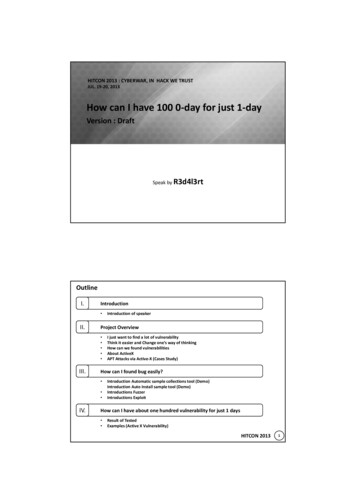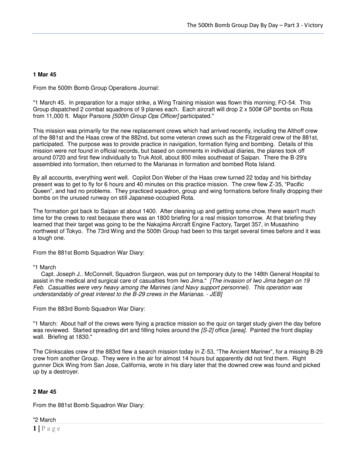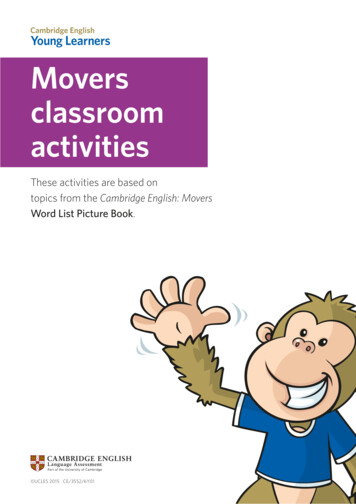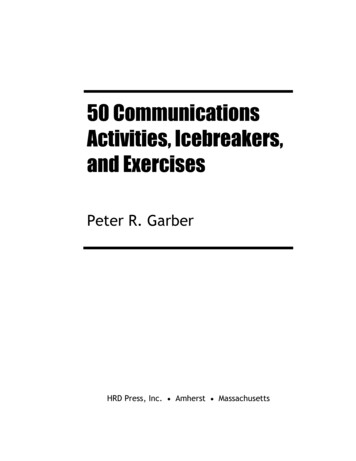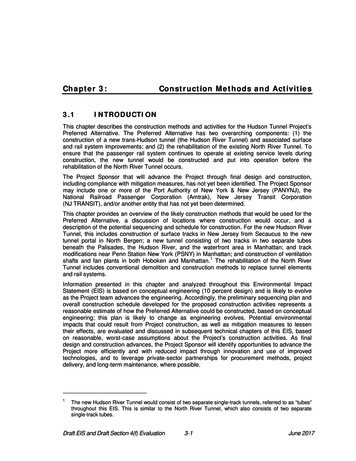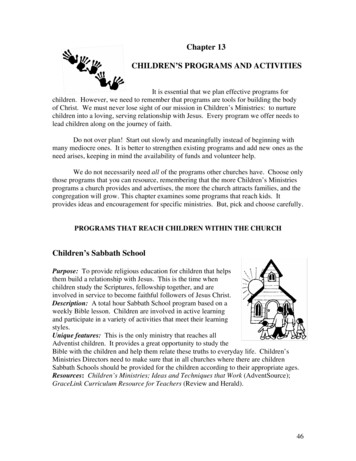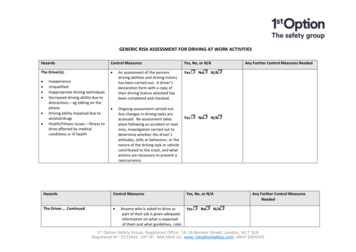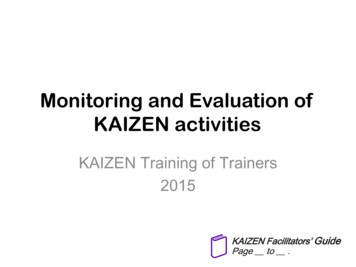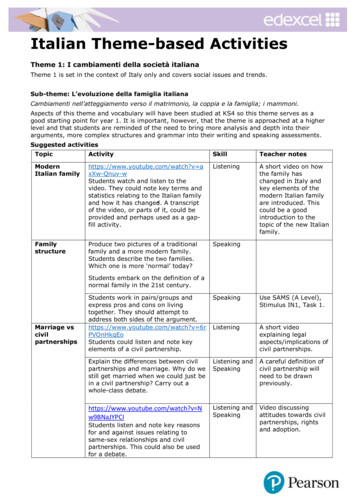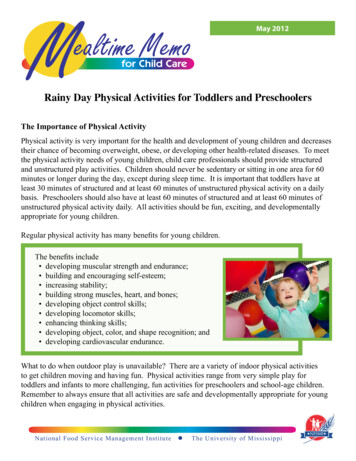
Transcription
May 2012for Child CareRainy Day Physical Activities for Toddlers and PreschoolersThe Importance of Physical ActivityPhysical activity is very important for the health and development of young children and decreasestheir chance of becoming overweight, obese, or developing other health-related diseases. To meetthe physical activity needs of young children, child care professionals should provide structuredand unstructured play activities. Children should never be sedentary or sitting in one area for 60minutes or longer during the day, except during sleep time. It is important that toddlers have atleast 30 minutes of structured and at least 60 minutes of unstructured physical activity on a dailybasis. Preschoolers should also have at least 60 minutes of structured and at least 60 minutes ofunstructured physical activity daily. All activities should be fun, exciting, and developmentallyappropriate for young children.Regular physical activity has many benefits for young children. The benefits include developing muscular strength and endurance; building and encouraging self-esteem; increasing stability; building strong muscles, heart, and bones; developing object control skills; developing locomotor skills; enhancing thinking skills; developing object, color, and shape recognition; and developing cardiovascular endurance.What to do when outdoor play is unavailable? There are a variety of indoor physical activitiesto get children moving and having fun. Physical activities range from very simple play fortoddlers and infants to more challenging, fun activities for preschoolers and school-age children.Remember to always ensure that all activities are safe and developmentally appropriate for youngchildren when engaging in physical activities.National Food Service Management Institute The University of Mississippi
Indoor Physical Activities for ToddlersFind the Applefor Child CareFind the Apple is a fun scavenger hunt for toddlers.Children will walk and search the classroom for hiddenMay 2012, continuedapples.Materials: Plastic red apples (15-20), basketBooks to Read: Apples, Apples by Kathleen WeidnerZoehfeldDirections: Hide apples in various places around theroom. Children will walk, hop, or crawl around theroom looking for the hidden apples. Walk, crawl, andhop with the children, encouraging them to look for themissing apples. As children find the apples, ask themto place them in the basket. This activity could be usedwith other plastic fruits and vegetables to teach children about healthy foods.Empty the Milk JugEmpty the Milk Jug is a fun, yet challenging physical activity for toddlers. Children will fill the jugwith milk (white clothespins) and shake the jug until it is empty.Materials: White clothespins (10-15) and 3-5 empty milk jugsBooks to Read: Moo, Moo Brown Cow! Have You Any Milk? By Phillis GershatorDirections: Demonstrate this activity by placing 10-15 clothespins inside an empty milk jug,shaking the jug until a clothespin falls out.The Sticky Foot RunwayThe Sticky Foot is a very simple yet fun game for toddlers. Children will attempt to walk, but theresistance of the walkway will be a challenge.Materials: 4-6 ft. clear contact paper (2 pieces), duck tape, music, and music playerBooks to Read: Wobble Bear by Ian WhybrowDirections: Position the contact paper on the floor with the sticky adhesive side up. Tape thecontact paper to the floor to avoid the paper moving or slipping. Assist children with taking theirshoes off. Demonstrate and assist children as they walk, dance, and hop across the sticky runway.Indoor Physical Activities for PreschoolersMusical Bubble ShapesMusical Bubbles is a fun and exciting game for young children. Children walk, jump, or danceacross bubble wrap as music is played.Materials: Bubble wrap (24-36 inches wide and 10-15 feet long), duck tape, music, and a musicalplayerBooks to Read: Shape by Shape by Suse MacDonaldDirections: Position the bubble wrap on the floor forming two to three shapes, for example asquare, diamond, and a triangle. Apply duck tape to secure the wrap from moving or slipping.Discuss the different types of shapes included in this activity with the children. Then explain to
the children the rules of the activity. Demonstrate theactivity by walking, jumping, hopping, or dancing acrossthe bubble wrap while the music is playing. When themusic stops, stop and tell what shape you are standingon. Repeat the activity and ask the children to join in asyou play the music.for Child CareMay 2012, continuedLet’s HopscotchLet’s Hopscotch is an activity that enhances balance andstrength in young children.Materials: Duck tape and small bean bagBooks to Read: Let’s Play Hopscoth by Sarah HughesDirections: Draw 10-15 connected boxes with duck tapeon the floor or carpet. Demonstrate the activity by throwinga bean bag to land on one of the boxes. Hop through theboxes avoiding the box with the bean bag. At the last box,turn around and return to the beginning. To make it morechallenging, add a second bean bag. In larger classes, draw2 or 3 diagrams for children to participate simultaneously.The Missing Fruit Game!The Missing Fruit game is an activity that teaches children about different fruitsMaterials: Fruit cards (pictures of fruit), plastic fruits (fruit should match the fruit cards)Books To Read: Eating the Alphabet by Lois EhlertDirections: Hide the plastic fruit in the classroom. Show the different fruit cards and explainwhy it is important to eat fruits daily. Distribute the fruit cards to the children. The only rule tothe game is no walking. Children must hop, march, crawl, tiptoe, or ski to find the missing fruit.Demonstrate each action (hop, march, tiptoe, or ski) for the children. As children find the fruit,distribute a new card until all the fruit have been found.Resources for Physical ActivitiesThere are several great resources for implementing physical activities. Most of the resourcesprovide step by step directions. Below is a list of resources and links to assist in selecting andimplementing physical activities. Curriculums, Best Practice Guidelines, and Books Early Steps Physical Education Curriculum: Theory and Practice for Children Under 8 byEvridiki Zachopoulou, Ian Pickup and Niki Tsangaridou Active Start: A Statement of Physical Activity Guidelines for Children From Birth to Age 5,2nd Edition by National Association for Sport and Physical Education - /ActiveStart.cfmnnThis project has been funded at least in part with Federal funds from the U.S. Department of Agriculture, Food and Nutrition Service through a grant agreement with The University ofMississippi. The contents of this publication do not necessarily reflect the views or policies of the U.S. Department of Agriculture, nor does mention of trade names, commercial products, ororganizations imply endorsement by the U.S. Government. The University of Mississippi is an EEO/AA/Title VI/Title IX/Section 504/ADA/ADEA Employer.
nnnnn eady, Set, Go! Creating and MaintainingRa Wellness Environment in Child CareCenters Participating in the CACFP byfor Child CareNational Food Service Management Institute- http://www.nfsmi.org/documentlibraryfiles/May 2012, continuedPDF/20110126034352.pdf Physical Education for Young Children: Movement ABCs for Little One by Rae Pica Nutrition and Physical Activity Resources by First 5 Association of California - 0Activity%20Report.pdf Healthy Habits for Life by Nemours, Health and Prevention Services, and KidsHealth.org- http://kidshealth.org/classroom/cc/GetMoving.pdf SPARK Early Childhood - http://www.sparkpe.org/early-childhood/ Website Head Start Body Start National Center for Physical Development and Outdoor Play - www.headstartbodystart.org FRAC: Child Care Program Wellness Toolkit - -and-policies/ CARE Connection (NFSMI) - http://www.nfsmi.org/ResourceOverview.aspx?ID 357nnn Initiatives Let’s Move! Child Care - reative Tips and Strategies for Implementation on Rainy Days Include music and dance. Be a role model for children by participating in physical activities with them. With the children's help, set up an obstacle course with chairs, cones, balls, and otheritems. Guide children on how to move through each part of the course so children cangain an understanding of directions in space such as over, under, around, and through. Place mats on the floor for tumbling, yoga, and movement. Play cooperative gamesusing hula hoops, streamers, parachutes, and beach balls. Role model and demonstrate all activities for children. Have a college football player or tennis player to visit the center to talk about physicalactivity. Create a Calendar of Physical EventsSourcesCraft, D. H., Smith, C.L. (2008). Active play! Fun physical activity for young children. Cortland, NY: Active Play Books.Kuffner, T. (1999). The toddler’s busy book. New York, Ny: Simon and Schuster.National Association for Sport and Physical Education.(2009). Active start: A statement of physical activity guidelines from birth to age 5, 2ndEdition. Retrieved from delines/ActiveStart.cfmNational Food Service Management Institute. (2009). Creating an active, healthy play environment. CARE Connection: Music, Movement andPlay Connection. Retrieved from 0827041303.pdf.In accordance with Federal law and U.S. Department of Agriculture policy, this institution is prohibited from discriminating on the basis of race, color, national origin, sex, age, or disability.To file a complaint of discrimination, write USDA, Director, Office of Civil Rights; Room, 326-W, Whitten Building, 1400 Independence Avenue, SW, Washington, DC 20250-9410 or call(202) 720-5964 (voice and TDD). USDA is an equal opportunity provider and employer.”
Nutrition HighlightsNational Message – USDA 2010 Dietary Guidelines Communications Message CalendarThe theme for May to August is Foods to Reduce. During this time, the selected key messageis “drink water instead of sugary drinks”. Remember the theme and selected message whenplanning activities for everyday activities. To obtain more information, follow the link at unicationsMessageCalendar.pdfNational Garden MonthMay is National Physical Fitness and Sports Month, sponsored by the President’s Council onFitness, Sports, and Nutrition (PCFSN). During this month, PCFSN promotes the value ofphysical activity and implementing healthy eating habits. Also during this month, the PCFSNseeks to “engage, educate, and empower all Americans in adopting and living a healthierlifestyle. To obtain more information, follow the link at http://www.fitness.gov/npfsm/NFSMI TrainingsNFSMI has a variety of online child care courses available. All online courses are free ofcharge and can be accessed at any time. Check out our online courses by following the t.aspx?qs cElEPTIzNg for Child CareMay 2012, continued
National Food Service Management Institute The University of Mississippi for Child Care for Child Care May 2012 . NFSMI has a variety of online child care courses available. All online courses are free of charge and can be accessed at any time. Check out o
